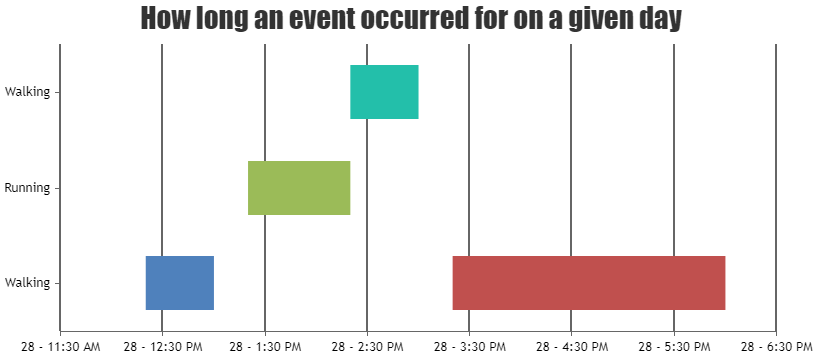Login to Ask a Question or Reply
Forum Replies Created by Ananya
-
You can pass any custom property within striplines, which can then be accessed programmatically. For instance, you might include a custom property like “data” in your stripline object and this won’t be displayed, but it will be available for use in your code.
stripLines:[ { value: 1940, label: "In the 40s", data: "my stripline" } ]The property can later be accessed through the chart options as
chart.options.axisX.stripLines[0].data.—
Ananya Deka
Team CanvasJS-
This reply was modified 7 months ago by
Ananya.
It is not possible to align the axes, as their minimum and maximum values are independent of each other. However, for your particular scenario you can set the maximum and minimum properties of Axis Y according to that of Axis Y2. Please take a look at this JSFiddle for an example of the same.
—
Ananya Deka
Team CanvasJSPlease create a sample project reproducing the issue you are facing and share it with us over Google-Drive or Onedrive, so that we can run it locally on our end, understand the scenario better and help you out.
—
Ananya Deka
Team CanvasJS-
This reply was modified 10 months, 3 weeks ago by
Ananya.
January 6, 2025 at 6:21 pm in reply to: Multi Series Range Area Charts without shared tooltip #60364In Range Area Chart with
tooltip.shared = false, tooltip is shown only when the mouse hovers over a specific datapoint, displaying the start and end values for that range. In multi-series chart, it will not combine values from different series and will show information for the hovered datapoint only. Whentooltip.shared = true, the tooltip appears even when not hovering directly over a datapoint, displaying information for the nearest datapoint based on the x-value and y-values across all the series.—
Ananya Deka
Team CanvasJSCanvasJS chart renders whatever datapoints are passed in chart-options. Generating the datapoints using the python library suggested in the article, and passing it to the chart should work in your case.
—
Ananya Deka
Team CanvasJSDecember 9, 2024 at 10:31 am in reply to: Problem with tooltip and “shared=true” with stackedArea #60264[UPDATE]
@rck,We have released chart v3.10.19 with the above fix. Please refer to the release blog for more information. Do download the latest commercial version from My Account Page and let us know your feedback.
—
Ananya Deka
Team CanvasJSPlease make sure that the CDN you are using in your project is that of stockchart (https://cdn.canvasjs.com/canvasjs.stock.min.js). If you are still facing issue after that, kindly check the browser console for any errors and let us know, so that we can understand the scenario better and help you out.
—
Ananya Deka
Team CanvasJSNovember 29, 2024 at 5:44 pm in reply to: Problem with tooltip and “shared=true” with stackedArea #60227@rck,
Thank you for reporting the use case, we will look into it further. Meanwhile, you can work around this by adding a datapoint in the scatter chart with the concerned x value, and set y value as null, so that tooltip is not shown in that region.
Please take a look at this updated JSFiddle for the working example of the same.

—
Ananya Deka
Team CanvasJS@arj,
Can you kindly create a sample project reproducing the issue and share it with us over Google-Drive or Onedrive so that we can run it locally at our end to understand scenario better, and help you out?
—
Ananya Deka
Team CanvasJSasbuka,
Date-time values over y axis is not supported as of now. However, formatting the timestamp values to show it as date-time using labelFormatter should work fine in this case. Please take a look at this JSFiddle for a working example of the same.

Please refer to this article for more information about creating Gantt Charts.
—
Ananya Deka
Team CanvasJSWe have released v3.10.15 GA with the fix for this bug. Please refer to the release blog for more information.
Do download the latest version from download page & let us know your feedback.
—
Ananya Deka
Team CanvasJS -
This reply was modified 7 months ago by